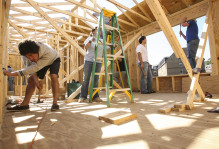A noticeable step forward
For six years now, we have traveled to Paraiso, Dominican Republic to host a week-long medical clinic, to conduct community field research, and to build partnerships for improving health and health care. Each year, we have traveled with an assortment of medical professionals who have been led from the beginning by Dr. Mark Ryan (’96). And, each year we have conducted basic ethnographic studies to identify and describe the community and to mark its social, cultural, and geographic boundaries. Over that period, we have collected data to describe water contamination and water flow within a flood control canal (cañada). We have described patterns of food consumption, sources of income, household composition, and access to electrical power and plumbing facilities.
We have come to understand that Paraiso is not a single community but rather a place name that encompasses distinct barrios, and that fact is crucially important for our work. We have conducted house-to-house interviews during the winter project trips and during the summers when funded undergraduate researchers returned for more intensive and extensive field studies. We have examined patterns of local leadership and interpersonal relationships using social network analysis (SNA).
For now, our community efforts focus on only one of the several barrios. Our community partnership strategy requires the capacity for collective action, and it is likely that effective collective action begins most easily with some shared sense of locality. It was a difficult decision: which barrio, and how to explain to the remaining barrios that we would be spending a disproportionate time in only one? In truth, we agonized over the decision – and finally chose Esfuerzo. Cut off from the rest of Paraiso by a flood plain and a bridge that crosses the cañada, Esfuerzo is the most recently “settled” of the sub-communities. (The land, in fact, is regarded as uninhabitable by the Dominican government. Most of those who live there technically are “squatting.”) Those who live in this community are regarded by some in other barrios as outsiders, not really part of Paraiso.
Our medical clinic continues to operate within an elementary school in Altos (one of the barrios that comprise Paraiso), and now there are two sessions each year. Through an agreement with H.O.M.B.R.E, a medical outreach project at VCU School of Medicine, Dr. Mark brings medical students to the community each summer to operate a clinic for two weeks. Our winter trip, which commences on December 31st, will include an unusually impressive entourage. In addition to the undergraduate students (and me) who comprise the SOMOS team, the following medical professionals and contributors include:
- Alix Pandolfino, PharmD
- Elisa Silverstein, M.D. (Rebecca Silverstein’s mother; Rebecca is a second year SOMOS student)
- Kristen Agura, Physician’s Assistant
- Matt Harrington, M.D., one of the founders of what we now call SOMOS
- Tamarah Rodriguez, M.D., born and educated in the Dominican Republic and soon to have yet another professional degree – from William and Mary
- Jim Donecker, 4th year medical student and former co-leader of SOMOS
- Treván Rankin, 4th year medical student
- Danielle Navalta, pharmacy student
- Nellie Jafari, pharmacy student
- Palak Patel, pharmacy student
- Bethany Morehouse, 4th year medical student
- Carrie Dolan , MPH., W&M professional faculty
- Jess Lucia, W&M alum and photo journalist
- Mark Ryan, M.D., Medical Director and co-founder of what now is called SOMOS
- David Aday, Ph.D., Academic Director, SOMOS
The SOMOS crew includes students with extensive experience, including Kevin Salinas, co-leader, summer researcher, and 4th year returning student; Joanna Weeks, who began her SOMOS experience even before graduating from high school, joining brother John for summer research experience and returning last summer for two months of summer research; and Amalhyn Shek, who is returning and has summer research experience. Other experienced SOMOS students include Taylor Hurst (co-leader), Rebecca Silverstein, Lindsay Schleifer, and Kaveh Sardeghian. Our newest members are August Anderson, Jeff Rhode, Mel Alim, and Melanie Rogers.
And here is the step forward: We bring with us a carefully developed draft for a five-year plan, focused on the health care priorities identified in house-to-house interviews, two community meetings, and a series of “block group” meetings. We have proposals for short-term projects that will bring some relief from problems of contaminated water, flooding, and hazardous waste and trash burning. And, we have some longer-term proposals that are grander in scale but promise more potent results. There are many variables to consider as we move forward, but none is as important as our effort to ensure with each step that community residents are engaged; that we are moving with them in directions that they have chosen; and that they share with us the responsibility for every aspect of this collective effort.
We have worked carefully and thoughtfully to come to this moment. We will need to employ everything that we’ve learned about community, organization, and participatory development to enact strategies that authentically invite participation, methods that genuinely are inclusive rather than exclusive, and a vision of the power of diversity for meeting basic human needs.
Comments are currently closed. Comments are closed on all posts older than one year, and for those in our archive.




Wow! So many medical providers this year! Best wishes for the clinic/research! :O)
Echoing Kristine– what a GREAT TEAM, and a great plan.
I’m on the edge of my seat to hear what has transpired.